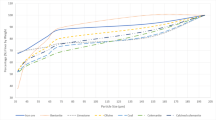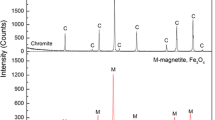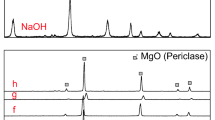Abstract
Accelerated one-dimensional unconfined swell tests were conducted for ferrous sulfate chromite ore processing residue (COPR) field-treated samples. The field-treated samples were subjected to wet and dry cycles over 100 days to accelerate the lithification of the samples. Parallel laboratory experiments were performed to investigate the effects of mineralogy on COPR swell under controlled conditions. The field and laboratory samples were treated with ferrous sulfate at a ferrous-to-Cr6+ molar stoichiometric ratios of eight (8×) and five (5×). X-ray powder diffraction (XRPD) and scanning electron microscopy (SEM)-energy dispersive X-ray spectroscopy (EDX) analyses were used to investigate the mineralogical changes upon treatment. The swell results indicated that significant COPR swelling was observed in all of the tested samples. The swelling was more pronounced in the 5× treated COPR sample than in the 8× treated COPR sample. Moreover, the laboratory-treated samples showed greater swelling behavior as compared with the field-treated samples, which was most probably due to the high dry density of the COPR, indicating that dry density was a more dominant factor than lithification. XRPD and SEM-EDX results confirmed that significant ettringite formation occurred in all treated samples.




Similar content being viewed by others
References
Burke T, Fagliano J, Goldoft M, Hazen RE, Iglewicz R, McKee T (1991) Chromite ore processing residue in Hudson County, New Jersey. Environ Health Perspect 92:131–137
Chrysochoou M, Dermatas D (2006) Evaluation of ettringite and hydrocalumite formation for heavy metal immobilization: literature review and experimental study. J Hazard Mater 136:20–33
Chrysochoou M, Dermatas D, Grubb DG, Moon DH, Christodoulatos C (2010) Importance of mineralogy in the geoenvironmental characterization and treatment of chromite ore processing residue. J Geotech Geoenviron Eng 36:510–521
Darrie G (2001) Commercial extraction technology and process waste disposal in the manufacture of chromium chemicals from ore. Environ Geochem Health 23:187–193
Dermatas D (1995) Ettringite-induced swelling in soils: state-of-the art. Appl Mech Rev 48:659–673
Dermatas D, Bonaparte R, Chrysochoou M, Moon DH (2006a) Chromite ore processing residue (COPR): contaminated soil or hazardous waste?. J ASTM Int 3(7):doi: 10.1520/JAI13313
Dermatas D, Chrysochoou M, Moon DH, Grubb DG, Wazne M, Christodoulatos C (2006b) Ettringite-induced heave in chromite ore processing residue (COPR) upon ferrous sulfate treatment. Environ Sci Technol 40:5786–5792
Dermatas D, Chrysochoou M, Moon DH, Kaouris M, Morris J, French C (2008) Current knowledge on heaving mechanism of chromite ore processing residue. In: Proceedings of GeoCongress 2008, New Orleans, Louisiana, March 9–12
Elzinga EJ, Cirmo A (2010) Application of sequential extractions and X-ray absorption spectroscopy to determine the speciation of chromium in Northern New Jersey marsh soils developed in chromite ore processing residue (COPR). J Hazard Mater 183:145–154
Farmer JG, Graham MC, Thomas RP, Licona-Manzur C, Paterson E, Campbell CD (1999) Assessment and modeling of the environmental chemistry and potential for remediative treatment of chromium-contaminated land. Environ Geochem Health 21:331–337
Farmer JG, Thomas RP, Graham MC, Geelhoed JS, Lumsdon DG, Paterson E (2002) Chromium speciation and fractionation in ground and surface waters in the vicinity of chromite ore processing residue disposal sites. J Environ Monit 4:235–243
Graham MC, Farmer JG, Anderson P, Paterson E, Hillier S, Lumsdon DG, Bewley R (2006) Calcium polysulfide remediation of hexavalent chromium contamination from chromite ore processing residue. Sci Total Environ 364:32–44
ICDD (2002) Powder diffraction file.PDF-2 database release, International Centre for Diffraction Data, Newtown Square, Pennsylvania, USA.
Jagupilla SC, Moon DH, Wazne M, Christodoulatos C, Kim MG (2009) Effects of particle size and acid addition on the remediation of chromite ore processing residue using ferrous sulfate. J Hazard Mater 168:121–128
James DR (1996) The challenge of remediating chromium-contaminated soil. Environ Sci Technol 30:248A–251A
MDI (2005) Jade version 7.1. Material’s Data Inc, Livermore
Moon DH, Chrysochoou M, Dermatas D, Christodoulatos C, Kaouris M, Morris J (2005) Investigation of ettringite formation in chrome ore processing residue. In: Proceedings of the 8th International In Situ and On-Site Bioremediation Symposium, Baltimore, Maryland, June 6–9
Moon DH, Dermatas D, Chrysochoou M, Shen G (2006) An investigation of the heaving mechanism related to chromite ore processing residue. J ASTM Int 3(6):doi: 10.1520/JAI13309
Moon DH, Wazne M, Dermatas D, Christodoulatos C, Sanchez AM, Grubb DG, Chrysochoou M, Kim MG (2007) Long-term treatment issues with chromite ore processing residue (COPR): Cr6+ reduction and heave. J Hazard Mater 143:629–635
Puppala AJ, Intharasombat N, Vempati RK (2005) Experimental studies on ettringite-induced heaving in soils. J Geotech Geoenviron 131:325–337
Taylor HFW, Famy C, Scrivener KL (2001) Review delayed ettringite formation. Cem Concr Res 31:683–693
USEPA (2007) Microwave assisted acid digestion of sediments, sludges, soils and oils. Method 3051A, Washington DC
Wazne M, Jagupilla SC, Moon DH, Jagupilla SC, Christodoulatos C, Kim MG (2007a) Assessment of calcium polysulfide for the remediation of hexavalent chromium in chromite ore processing residue (COPR). J Hazard Mater 143:620–628
Wazne M, Moon DH, Billapati SS, Jagupilla S, Christodoulatos C, Dermatas D, Chryschoou M (2007b) Remediation of chromite ore processing residue (COPR) using ferrous sulfate and calcium polysulfide. Geosci J 11:105–110
Weng CH, Huang CP, Allen HE, Cheng AHD, Sanders PF (1994) Chromium leaching behavior in soil derived from chromite ore processing waste. Sci Total Environ 154:71–86
Author information
Authors and Affiliations
Corresponding authors
Additional information
Responsible editor: Bingcai Pan
Rights and permissions
About this article
Cite this article
Moon, D.H., Wazne, M., Dermatas, D. et al. Evaluation of ettringite-related swelling mechanisms for treated chromite ore processing residue. Environ Sci Pollut Res 22, 738–744 (2015). https://doi.org/10.1007/s11356-014-3554-8
Received:
Accepted:
Published:
Issue Date:
DOI: https://doi.org/10.1007/s11356-014-3554-8




